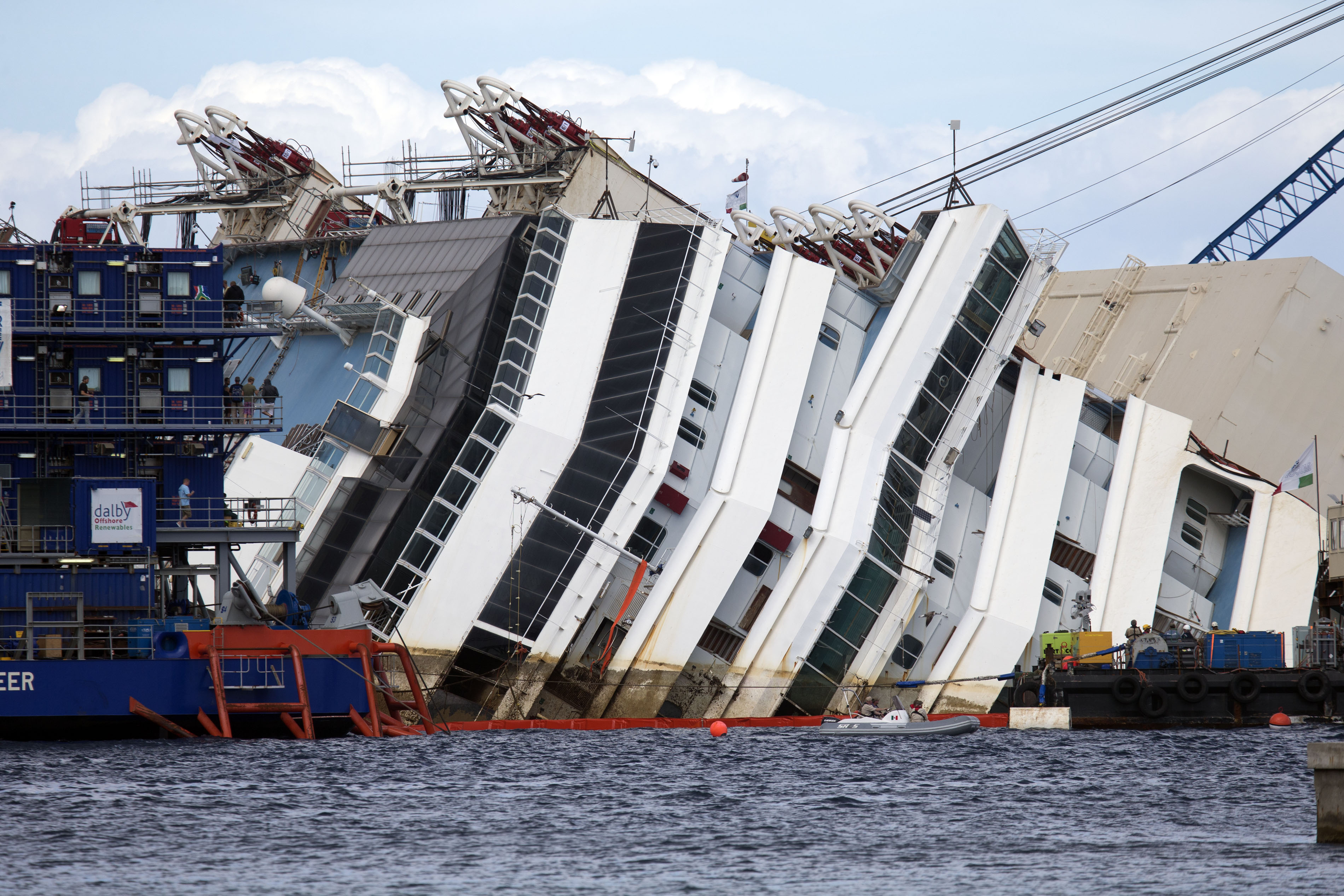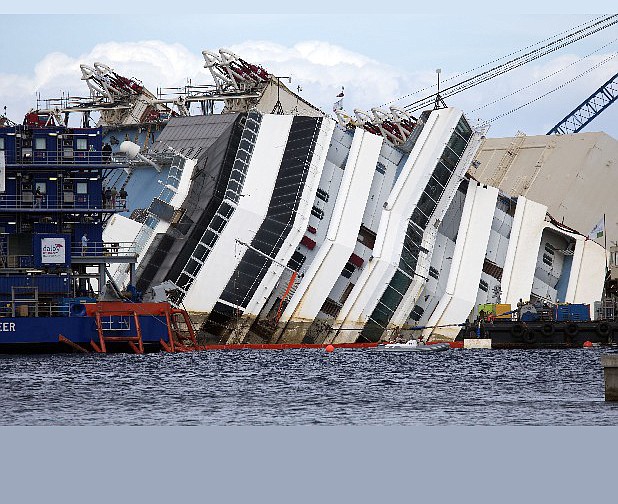 The Costa Concordia ship lies on its side on the Tuscan Island of Giglio, Italy, on Monday. In an unprecedented maritime salvage operation, engineers on Monday gingerly wrestled the hull of the shipwrecked Costa Concordia off the Italian reef where the cruise ship has been stuck since January 2012. But progress was much slower than predicted and the delicate operation to rotate the luxury liner from its capsized position to upright appeared likely to stretch into Tuesday. Never before has such an enormous cruise ship been righted, and the crippled Concordia didn't budge for the first three hours after the operation began, engineer Sergio Girotto told reporters.
The Costa Concordia ship lies on its side on the Tuscan Island of Giglio, Italy, on Monday. In an unprecedented maritime salvage operation, engineers on Monday gingerly wrestled the hull of the shipwrecked Costa Concordia off the Italian reef where the cruise ship has been stuck since January 2012. But progress was much slower than predicted and the delicate operation to rotate the luxury liner from its capsized position to upright appeared likely to stretch into Tuesday. Never before has such an enormous cruise ship been righted, and the crippled Concordia didn't budge for the first three hours after the operation began, engineer Sergio Girotto told reporters.GIGLIO ISLAND, Italy - Engineers declared success on Tuesday as the Costa Concordia cruise ship was pulled completely upright during a complicated, 19-hour operation to wrench it from its side where it capsized last year off Tuscany, an unprecedented feat that sets the stage for it to be towed away next year.
The submerged side of the Concordia suffered significant damage during 20 months bearing the weight of the ship and the operation to right it, officials said. That damage must be repaired to stabilize the ship so it can be towed and turned into scrap.
Shortly after 4 a.m., a foghorn wailed off Giglio Island and the head of Italy's Civil Protection agency, Franco Gabrielli, announced that the ship had reached vertical and that the operation to rotate it - known in nautical terms as parbuckling - was complete.
"We completed the parbuckling operation a few minutes ago the way we thought it would happen and the way we hoped it would happen," said Franco Porcellacchia, project manager for the Concordia's owner, Costa Crociere SpA.
"A perfect operation, I must say," with no environmental spill detected so far, he said.
Applause rang out among firefighters in the tent where the project engineers made the announcement. An hour later, Nick Sloane, the South African chief salvage master, received a hero's welcome as he came ashore from the barge that had served as the floating command control room for the operation.
"Brilliant! Perfetto," Sloane said, using some of the Italian he has learned over the past year on Giglio preparing for the operation. "It was a struggle, a bit of a roller coaster. But for the whole team it was fantastic."
The Concordia slammed into a reef off Giglio Island on Jan. 13, 2012, after the captain brought it too close to shore. The cruise ship drifted, listed and capsized just off the island's port, killing 32 people. Two bodies were never recovered.
The operation to right it had been expected to take no more than 12 hours, but dragged on after some initial delays and maintenance on the vast system of steel cables, pulleys and counterweights that were used to roll the 115,000-ton, half-submerged carcass of steel upright. The final phase of the rotation went remarkably fast as gravity began to kick in and pull the ship toward its normal vertical position.
Parbuckling is a standard operation to right capsized ships. But never before had it been used on such a huge cruise liner.
The Concordia is expected to be floated away from Giglio in the spring and turned into scrap. The aim was to right it intact, to prevent the leakage of potentially toxic waste into the pristine waters around Giglio, which is located in a marine sanctuary.
Sloane said an initial inspection of the starboard side, covered in brown slime from its 20 months underwater perched on a jagged reef, indicated serious damage that must be fixed in the coming weeks and months. The damage he said was caused by the capsizing, bearing 20 months of the ship's weight and the operation to rotate the ship.
"We have to do a really detailed inspection of the damage," to determine how to shore it up so it can withstand towing. But Sloane seemed confident: "She was strong enough to come up like this, she's strong enough to be towed."
The starboard side of the ship, which was raised 65 degrees in the operation, must be stabilized to enable crews to attach empty tanks on the side that will later be used to help float the vessel away. Such tanks were affixed to the exposed, port side of the ship and were filled with water in the later phases of the rotation to help pull the port side down.
The ship must be made strong enough to withstand the winter storm season, when high seas and gusts will likely buffet the 300-meter (1,000-foot) long liner.
After receiving cheers, embraces and a kiss from his wife on shore, Sloane said he wanted to get some sleep, a beer "and maybe a barbeque tomorrow." He was later seen celebrating in a harborside bar with members of the salvage team.
"I think the whole team is proud of what they achieved," he said as he was mobbed by well-wishers and television crews, still wearing an orange life vest around his neck and carrying a South African flag in his hand, given to him by his wife.
Helping the Concordia to weather the winter and stabilize it is an artificial platform on the seabed that was constructed to support the ship's flat keel.
"The ship is resting on its platform," Gabrielli said.
About an hour before the rotation was complete, observers said the ship seemed to suddenly settle down upon its new perch, with a clear brown-green line of algae drawn across its front delineating the half of the liner that had been underwater and the half that was exposed.
Mayor Sergio Ortelli said the island felt a wave of relief as soon as the Concordia was freed from the reef in the initial hours of the operation. But he said there was also the realization that two bodies still have yet to be found, with a fresh search to be launched now that the ship is upright.
"While there is happiness today, there is no triumphalism," he told The Associated Press.
The Concordia's captain is on trial for alleged manslaughter, causing a shipwreck and abandoning the ship during the chaotic and delayed evacuation. Capt. Francesco Schettino claims the reef wasn't on the nautical charts for the liner's weeklong Mediterranean cruise. Five other Costa employees were convicted of manslaughter in a plea bargain and were sentenced to less than three years apiece.
Costa is a division of Miami-based Carnival Corp., the world's largest cruise company.
